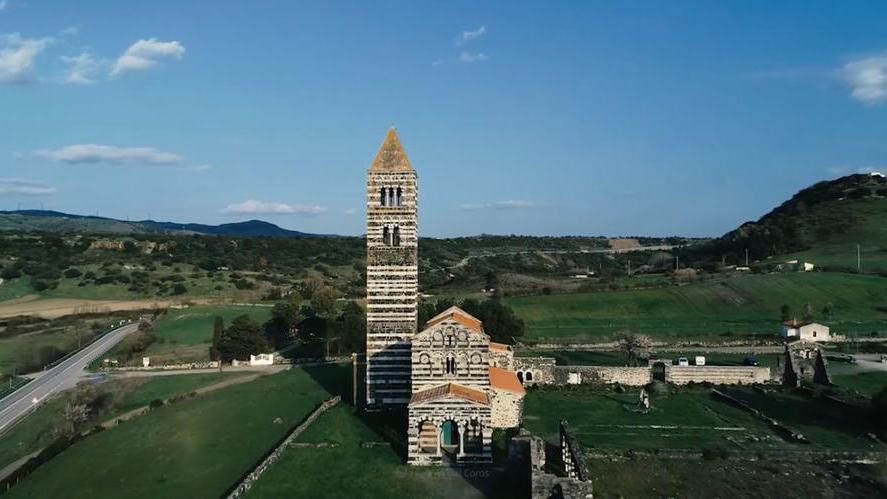Codrongianos traditions and art in the shadow of Saccargia the church wanted by the Judge
«Our village is a small jewel of art, history, culture, and beauty, located just a few kilometers from Sassari, the capital of northern Sardinia. This its ancient vocation, like that of hospitality, are the essential figures that best describe the community and on which we are focusing for growth in the future».
In the words of the first citizen Cristian Budroni, pride of belonging but also a vision for the future, which will pass in the coming years through an articulated series of interventions, including that of the Bando Borghi funded by the Ministry of Culture with more than one million euros. «Not only material works, but above all an accompaniment of the community in a path of skills enhancement, with activities linked to the social, cultural and business spheres also to support the productive realities present in the area» Budroni emphasizes. Codrongianos is above all known for the nearly 1,000-year-old Basilica of the Holy Trinity of Saccargia, one of the most important examples of Romanesque-Pisan architecture in Sardinia and the subject of numerous studies. The imposing bell tower and the characteristic bichromy, given by the alternation of limestone and basalt ashlars, are the distinguishing features of the medieval church, which stands close to today's State Road 597, outcropping and dominating the Saccargia plain. What welcomes visitors today is only the surviving part of the larger Camaldolese temple, consisting of a large monastery with an adjoining cloister of which only a few ruins remain today, but they hint at the majesty of the complex and its importance in the social, ecclesiastical, but also economic fabric of the late Middle Ages. As always, history and legend intertwine to tell the story of a place and fascinate visitors. Even two legends tell of its foundation. In the first, a spotted cow reached the valley and knelt where the Basilica now stands while, the second, of a more historical stamp, sees the presence in Saccargia of Judge Constantine of Torres and his wife Marcusa who, in their intent to reach Porto Torres to supplicate the three protomartyrs from Turretia so that they might have the grace of an heir, had a vision of a pregnant cow and, considering it a sign of grace obtained, decided, as a sign of thanksgiving, to erect the Basilica and name it after the Holy Trinity.
The Basilica of Saccargia is not only a symbolic place from a religious point of view, but it is also the setting where important cultural and social events take place: to be mentioned first of all is the Festival on literary journalism “Liquida”, now in its fifth edition and which has established itself as a fixture of the Codrongianese summer that attracts important names in journalism to discuss a variety of issues such as the environment, politics and the economy. The history of the Codrongianese community, however, has much deeper roots than that of the Romanesque basilica. Born close to the old Carlo Felice state road, Codrongianos is a small town of about 1,300 inhabitants with a genesis linked to historical, cultural and faith events that have shaped its identity. The presence of numerous nuraghi - among the most important is the Nuraghe Nieddu - dates its founding well before that. We find Codrongianos again in Roman times when, near the military camp, Castrum Gordianus (from which today's name would probably derive) there was a horse shed on the road from Karalis (Cagliari) leads to Turris Libisonis, Porto Torres. The same urban layout of the military camp shaped today's street grid, with Codronzanu de sutta and Codronzanu de subra (Codrongianos above and below). The narrow streets of the historic center with their ups and downs have preserved the ancient conformation making it, as it is often called, a life-size nativity scene. One of the oldest and most valuable buildings in the historic center is certainly the Church dedicated to the Conversion of St. Paul the Apostle, already counted among the possessions of the Camaldolese since 1125, which houses important works of art inside, including the Conversion of St. Paul attributed to Baccio Gorini, the pulpit, the baptistery and the marble high altar by the sculptor Sartorio. At the Church of St. Paul was also formed the faith of Elisabetta Sanna, from Codrongianese, a Franciscan tertiary and member of the Society of the Catholic Apostolate of St. Vincent Pallotti, declared Blessed by Pope Francis in 2016, whose home is located in the historic center, accessible to visitors. The Blessed's relic is housed in the Church of St. Paul. Of particular interest is the Codrongianos Documentary Research Center (picture gallery), an early 20th-century building where priceless artistic works of the community are displayed. Codrongianos today is a vibrant community, which is mainly recognized in the organization of the Holy Trinity of Saccargia festivities, during which it is customary to find in the village the many Codrongianos people who have emigrated abroad. But they are not just culture. Codrongianos is also hospitality and the joy of being together, including in the sharing of traditional products, such as the “ciccioneddos”, typical fresh pasta made by hand with only semolina, salt and water of which the local Pro Loco organizes the ritual festival, which not only brings the population together, but also constitutes an attraction for casual tourists and lovers of good food and passes down the ancient art from one generation to the next.

